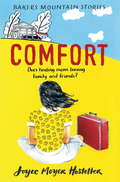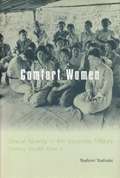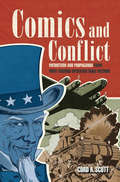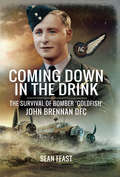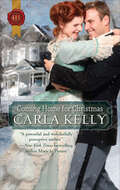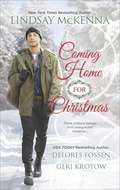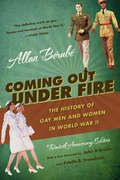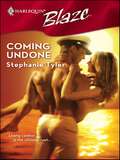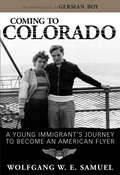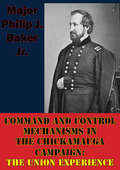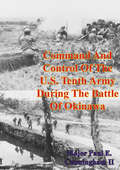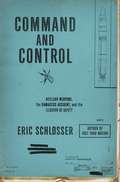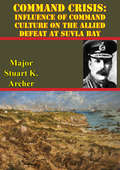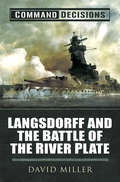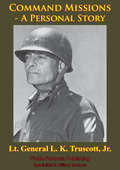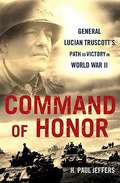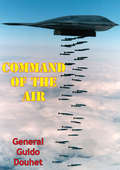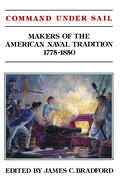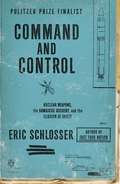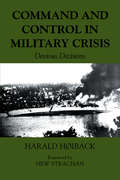- Table View
- List View
Comes the War (Eddie Harkins #2)
by Ed RuggeroSet against the heroism and heartbreak of WW II, former Army officer Ed Ruggero's Comes the War brilliantly captures the timeless stories of ordinary people swept up in extraordinary times April 1944, the fifty-fifth month of the war in Europe. The entire island of Britain fairly buzzes with the coiled energy of a million men poised to leap the Channel to France, the first, riskiest step in the Allies’ long slog to the heart of Germany and the end of the war.Lieutenant Eddie Harkins is tasked to investigate the murder of Helen Batcheller, an OSS analyst. Harkins is assigned a British driver, Private Pamela Lowell, to aid in his investigation. Lowell is smart, brave and resourceful; like Harkins, she is prone to speak her mind even when it doesn’t help her.Soon a suspect is arrested and Harkins is ordered to stop digging. Suspicious, he continues his investigation only to find himself trapped in a web of Soviet secrets. As bombs fall, Harkins must solve the murder and reveal the spies before it is too late.At the Publisher's request, this title is being sold without Digital Rights Management Software (DRM) applied.
Comfort (Bakers Mountain Stories Ser.)
by Joyce Moyer HostetterNow that Daddy has returned from fighting Hitler and Ann Fay is home from the polio hospital, life should get back to normal. But Ann Fay discovers she no longer fits easily into old friendships and Daddy has been traumatized by the war. Her family and social life are both falling apart. Ever responsible, she tries to fix things until she finally admits that she herself needs fixing. She travels to the Georgia Warm Springs Foundation, founded by Franklin D. Roosevelt, where she finds comfort, healing, and even a little romance. Although this invigorating experience does not solve all her problems, it does give Ann Fay a new view of herself. In this Parents' Choice Awards Recommended Book, sequel to Blue, Ann Fay makes new friends, reevaluates old relationships and discovers her unique place in the community.
Comfort Women: Sexual Slavery in the Japanese Military During World War II
by Yoshimi Yoshiaki Suzanne O'BrienYoshimi Yoshiaki provides a wealth of documentation and testimony to prove the existence of some 2,000 centers where as many as 200,000 Korean, Filipina, Taiwanese, Indonesian, Burmese, Dutch, Australian, and some Japanese women were restrained for months and forced to engage in sexual activity with Japanese military personnel. Many of the women were teenagers, some as young as fourteen. To date, the Japanese government has neither admitted responsibility for creating the comfort station system nor given compensation directly to former comfort women. This English edition updates the Japanese edition originally published in 1995 and includes introductions by both the author and the translator placing the story in context for American readers.
Comics and Conflict
by Cord A. ScottIllustration has been an integral part of human history. Particularly before the advent of media such as photography, film, television, and now the Internet, illustrations in all their variety had been the primary visual way to convey history. The comic book, which emerged in its modern form in the 1930s, was another form of visual entertainment that gave readers, especially children, a form of escape.As World War II began, however, comic books became a part of propaganda as well, providing information and education for both children and adults. This book looks at how specific comic books of the war genre have been used to display patriotism, adventure through war stories, and eventually to tell of the horrors of combat-from World War II through the current conflicts in Iraq and Afghanistan in the first decade of the twenty-first century.This book also examines how war- and patriotically-themed comics evolved from soldier-drawn reflections of society, eventually developing along with the broader comic book medium into a mirror of American society during times of conflict. These comic books generally reflected patriotic fervor, but sometimes they advanced a specific cause. As war comic books evolved along with American society, many also served as a form of protest against United States foreign and military policy. During the country's most recent wars, however, patriotism has made a comeback, at the same time that the grim realities of combat are depicted more realistically than ever before.The focus of the book is not only on the development of the comic book medium, but also as a bell-weather of society at the same time. How did they approach the news of the war? Were people in favor or against the fighting? Did the writers of comics promote a perception of combat or did they try to convey the horrors of war? All of these questions were important to the research, and serve as a focal point for what has been researched only in limited form previously.The conclusions of the book show that comic books are more than mere forms of entertainment. Comic books were also a way of political protest against war, or what the writers felt were wider examples of governmental abuse. In the post 9/11 era, the comic books have returned to their propagandistic/patriotic roots.
Coming Down in the Drink: The Survival of Bomber 'Goldfish', John Brennan DFC
by Sean FeastComing Down in the Drink is the story of Flight Lieutenant John Brennan DFC. John is an Irishman who need not have fought in the war at all. A sense of adventure took him to London where he trained as a chef before joining the RAF and qualifying as a wireless operator/air gunner.Posted to 148 Squadron in the Middle East in 1941, John was soon in the fray as the front gunner of a Wellington, flying daily sorties to Benghazi in what was known as the mail run, bombing enemy ships that were offloading vital supplies to Rommel and the Afrika Korps. As much at risk from faulty engines as enemy action, John completed a tour of almost 300 hours of operational flying, including an operation in March 1942 in which his Wellington suffered an engine failure and came down in the sea. He thus became a member of the Goldfish Club.Posted home and commissioned, he spent time instructing in Scotland, surviving yet another accident in which his pilot crashed into a mountainside. Volunteering for a second tour, John joined 78 Squadron in the summer of 1944, being crewed with one of the flight commanders. He completed his tour, this time as a wireless operator, in March 1945, by which time they were operating in daylight in support of the Allied advance. He was awarded the DFC.John is one of the only surviving wartime members of the Goldfish Club, and has a fascinating record of 63 operations that covers both the forgotten bombing war in the Middle East in 1941/42, operating from strips of sand in the barren desert, to a main force heavy bomber squadron in the snow of Yorkshire at the end of the war.
Coming Home
by Roy E. StolworthyA powerful novel of a teenager who fights in the First World War, hoping to redeem himself after the death of his brother. Feeling responsible for the accidental death of his recently conscripted brother, fifteen-year-old Thomas Elkin takes on the identity of his dead sibling—and enters into the fray of the conflict. His burning ambition is to die a glorious death in his brother&’s name. Believing that in fully submitting to the reality of war he is atoning for his sins, he faces all the attendant horrors with a steel will and a poignant resignation. As the Great War rages, both personal conflict and global conflict raise questions of morality and mortality, guilt and faith—as this moving novel touches upon the existential crises faced on the battlefield by the men who fought.
Coming Home For Christmas
by Carla KellyIn this historical family saga from a RITA award-winning author, three generations of soldiers find love during the holiday season. 1812: &“A Christmas in Paradise&” To save nurse Laura Ortiz from destitution, British naval surgeon Thomas Wilkie has made her an offer this Christmas—a marriage of convenience. . . . 1855: &“O Christmas Tree&” A generation later, it's Thomas and Laura's daughter, widowed single mother Lilian, who&’s working as a nurse in the Crimea. Christmas seems a long way away—until Major Trey Wharton helps her bring back the festive sparkle. 1877: &“No Crib for a Bed&” Lilian's son Captain Wilkie Wharton is finally on his way home from Fort Laramie. It's a long, arduous, life-changing train journey . . . which sees him discover his soul mate and the true meaning of Christmas! Praise for Carla Kelly: &“A powerful and wonderfully perceptive author.&” —Mary Jo Putney, New York Times–bestselling author of The Wild Child
Coming Home for Christmas
by Delores Fossen Lindsay Mckenna Geri KrotowThree stories salute the romance of holiday homecomings Christmas Angel by Lindsay McKenna When Navy SEAL Kyle Anderson gets a call saying Anna Campbell needs him, he doesn't think twice. On the Montana ranch where they grew up, holiday magic permeates every acre, kindling long-awaited love. But will duty trump desire? Unexpected Gift by Delores Fossen Tailed by a camera crew, Air Force Captain Gabe Brenner returns to Texas to deliver a Christmas message to his best friend's sister Kelly Coburn. But she's had her own delivery: beautiful baby Noel...Gabe's daughter. Navy Joy by Geri Krotow Chief Petty Officer Ian Cairne arrives stateside for Christmas with a four-legged friend: his late buddy's military service dog. Fortunately, the beautiful town vet Wendi Cooper is willing to take this odd couple into her home-and her heart.
Coming Out Under Fire: The History of Gay Men and Women in World War II
by Allan BérubéDuring World War II, as the United States called on its citizens to serve in unprecedented numbers, the presence of gay Americans in the armed forces increasingly conflicted with the expanding antihomosexual policies and procedures of the military. In Coming Out Under Fire, Allan Bérubé examines in depth and detail these social and political confrontations-not as a story of how the military victimized homosexuals, but as a story of how a dynamic power relationship developed between gay citizens and their government, transforming them both. Drawing on GIs' wartime letters, extensive interviews with gay veterans, and declassified military documents, Bérubé thoughtfully constructs a startling history of the two wars gay military men and women fought-one for America and another as homosexuals within the military. Bérubé's book, the inspiration for the 1995 Peabody Award-winning documentary film of the same name, has become a classic since it was published in 1990, just three years prior to the controversial "don't ask, don't tell" policy, which has continued to serve as an uneasy compromise between gays and the military. With a new foreword by historians John D'Emilio and Estelle B. Freedman, this book remains a valuable contribution to the history of World War II, as well as to the ongoing debate regarding the role of gays in the U. S. military.
Coming Undone
by Stephanie TylerSurfer-make that ex-surfer-Carly Winters can't believeshe accidentally faxed an erotic letter to...a secure militaryline? Now navy SEAL Jonathon "Hunt" Huntington is ather door, fax in hand, asking her how the fantasy ends.Because Carly's parents think Hunt is her new boyfriend,and Carly does need a wedding date ASAP, Hunt's readyto play-only on one condition. Carly's got to teach him tohang ten. Problem is it's been a while since Carly's career-ending accident and she's terrified of anything aqua. But with Hunt, letting go just may make her fantasy a reality!
Coming to Colorado: A Young Immigrant's Journey to Become an American Flyer (Willie Morris Books in Memoir and Biography)
by Colonel Wolfgang W. SamuelIn his acclaimed memoir German Boy: A Refugee’s Story, Wolfgang W. E. Samuel relates his experiences as a child surviving war and its hellish aftermath in occupied Germany. On January 24, 1951, exactly six years after his traumatic flight from Russian tanks, Samuel finds himself standing at the railing of a ship taking him to the land of his dreams—America. Coming to Colorado is the story of a refugee from war and deprivation, who at age sixteen, not understanding a word of English and with barely an eighth-grade education, leaves behind all that is familiar. Scarred by the violence, rape, and death he has seen, Samuel must first learn to be a boy again. But every relationship he tries to build must overcome the specter of his childhood experience in World War II and the chaos that followed. Shortly after his arrival in Colorado, Samuel spends what little money he has on a pair of second lieutenant’s bars that he finds in a Denver pawnshop. These bars, just like those worn by the American pilots he idolized during the Berlin Airlift, remind him of the airmen and the planes that instilled in him a dream to fly. That aspiration, however, faces long odds. Struggling to learn the English language and American customs, Samuel begins to lose faith in his abilities, suffers depression, and is haunted by both recurring nightmares of his violent past and survivor’s guilt. Coming to Colorado charts the path of Samuel’s eventual triumph. In 1960, his proud mother saw pinned on his shoulders the gold bars of a second lieutenant in the United States Air Force. It was the end of a struggle for the German boy, who had become, as he wished, the ultimate American.
Command And Control Mechanisms In The Chickamauga Campaign: The Union Experience
by Major Philip J. Baker Jr.This thesis analyzes how Major General William S. Rosecrans, commander of the Army of the Cumberland, employed the command and control mechanisms available to him as he maneuvered his army from Tullahoma, Tennessee toward Chattanooga, Tennessee in August-September, 1863. It also analyzes how these mechanisms were employed during the battle of Chickamauga itself, on 19-20 September, 1863.General Rosecrans possessed three mechanisms for commanding and controlling his army. The first was the military telegraph, provided by the quasi-military U.S. Military Telegraph service. Next were the assets of the fledgling U.S. Signal Corps, which consisted of signal flags and torches, and a portable version of the telegraph. Finally, there were couriers, who were usually mounted, and were provided by subordinate unit details, or by units specifically formed for courier duty.The thesis concludes that General Rosecrans did not use his command and control mechanisms effectively. Rosecrans relied too heavily on couriers to carry messages over densely wooded, cross-compartmented terrain in order to send orders to his widely dispersed subordinates and receive information from them. While Rosecrans made wide use of the military telegraph, to include using it during the battle itself, he did not effectively use his Signal Corps assets. These assets were used essentially as static observation posts, and only to a limited degree as a means for effecting command and control.The thesis further concludes, however, that General Rosecrans use of command and control assets was not a decisive factor in the outcome of the campaign or battle. While his reliance upon courier assets added significantly to the time required to obtain information and send orders, it was not the reason for the Union defeat at Chickamauga.
Command And Control Of The U.S. Tenth Army During The Battle Of Okinawa
by Major Paul E. Cunningham IIFrom 1 April 1945 to 21 June 1945, the United States Tenth Army, commanded by Lieutenant General Simon B. Buckner, Jr., executed Operation Iceberg--the seizure of Okinawa for use as a staging base for the expected invasion of Japan. The Tenth Army, which included the U.S. Army's XXIV Corps and the U.S. Marines Corps' III Amphibious Corps, executed an amphibious assault on Okinawa against the Japanese 32nd Army. The Japanese defenders allowed the Tenth Army to land virtually unopposed, preferring to fight a battle of attrition from strong fortifications. The Tenth Army rapidly seized the lightly defended northern end of the island, but became quickly bogged down against the main Japanese defensive belt on southern Okinawa. Japanese air power repeatedly assaulted the supporting Allied naval force with massed kamikaze attacks, resulting in heavy casualties. Ultimately, Lt. Gen. Buckner committed both corps to a frontal attack on the Japanese defenses in southern Okinawa and the campaign lasted some eighty two days before the final collapse of the 32nd Army. This thesis examines the effectiveness of Buckner and his staff's command and control of the Tenth Army. Buckner and his staff succeeded, but flaws in Buckner's generalship and his staff's failure to provide him with an accurate battlefield picture prolonged the campaign.
Command And Control: Nuclear Weapons, The Damascus Accident, And The Illusion Of Safety
by Eric Schlosser"The New Yorker" "Excellent. . . hair-raising. ". . Command and Control" is how nonfiction should be written. " (Louis Menand) Famed investigative journalist Eric Schlosser digs deep to uncover secrets about the management of America's nuclear arsenal. A ground-breaking account of accidents, near-misses, extraordinary heroism, and technological breakthroughs, "Command and Control" explores the dilemma that has existed since the dawn of the nuclear age: how do you deploy weapons of mass destruction without being destroyed by them? That question has never been resolved--and Schlosser reveals how the combination of human fallibility and technological complexity still poses a grave risk to mankind. Written with the vibrancy of a first-rate thriller, "Command and Control" interweaves the minute-by-minute story of an accident at a nuclear missile silo in rural Arkansas with a historical narrative that spans more than fifty years. It depicts the urgent effort by American scientists, policymakers, and military officers to ensure that nuclear weapons can't be stolen, sabotaged, used without permission, or detonated inadvertently. Schlosser also looks at the Cold War from a new perspective, offering history from the ground up, telling the stories of bomber pilots, missile commanders, maintenance crews, and other ordinary servicemen who risked their lives to avert a nuclear holocaust. At the heart of the book lies the struggle, amid the rolling hills and small farms of Damascus, Arkansas, to prevent the explosion of a ballistic missile carrying the most powerful nuclear warhead ever built by the United States. Drawing on recently declassified documents and interviews with men who designed and routinely handled nuclear weapons, "Command and Control "takes readers into a terrifying but fascinating world that, until now, has been largely hidden from view. Through the details of a single accident, Schlosser illustrates how an unlikely event can become unavoidable, how small risks can have terrible consequences, and how the most brilliant minds in the nation can only provide us with an illusion of control. Audacious, gripping, and unforgettable, "Command and Control "is a tour de force of investigative journalism, an eye-opening look at the dangers of America's nuclear age. "Time "magazine "A devastatingly lucid and detailed new history of nuclear weapons in the U. S. . . . fascinating. " (Lev Grossman) "Financial Times" "So incontrovertibly right and so damnably readable. . . a work with the multilayered density of an ambitiously conceived novel. . . Schlosser has done what journalism does at its best. " "Los Angeles Times""Deeply reported, deeply frightening. . . a techno-thriller of the first order. "
Command Authority (A Jack Ryan Novel #14)
by Tom Clancy Mark GreaneyDecades ago, as a young CIA analyst, President Jack Ryan Sr. was sent out to investigate the death of an operative--only to uncover the existence of a KGB assassin codenamed Zenith. He was never able to find the killer...In the present, a new strongman has emerged in the ever-chaotic Russian republic--the enigmatic President Valeri Volodon. But the foundations of his personal empire are built on a bloody secret from his past. And none who know of it have lived to tell. For he has set a plot in motion--a plot to return Russia to its former glory.But when a family friend of Ryan's is poisoned by a radioactive agent, the trail leads to Russia. And Jack Ryan Jr.--aided by his compatriots John Clark and the covert warriors of the secretive Campus--must delve into an international conflict thirty years in the making, and finish what his father started.With President Ryan fighting the political battle of his life, and his son fighting a silent war against a ruthless foe, global conflict becomes imminent--and the possibility of survival may soon be lost for all...
Command Crisis: Influence Of Command Culture On The Allied Defeat At Suvla Bay
by Major Stuart J. ArcherThe IX Corps of the British Mediterranean Expeditionary Force (MEF) achieved a complete tactical surprise of the Turkish defenders with its landing on 6 August 1915. Yet, despite a huge superiority in resources and a ten-to-one advantage in men, the IX Corps failed to obtain its planned objectives. This study examines the extent that the outcome of the British failure was influenced by the prevalent British Army command culture.The British Army command culture of 1916 was directly linked to its past as a colonial police force. Although well suited for that role, it was unable to effectively deal with the changes in warfare and the rapidly expanding sizes of armies in 1916. The British command culture of the time consisted a personalized system that exercised a reliance on a system of seniority, a hands-off method of command at the senior and operational levels, and a restrictive method of control at the tactical level.
Command Decision
by William Wister Haines"This taut, continuously engrossing novel of an American bomber command based in England packs a solid impact from its first page." - The New York Times (Jan. 5, 1947) "Rare it is that a piece of fiction smacks the reader between the eyes with conviction that it has burst spontaneously from the narrator's brain and is a story that HAD to be told." - Chicago Tribune (Jan. 5, 1947) Leader of an elite team of American heavy bomber planes, General Casey Dennis of the US Air Force is sent to England during the height of World War II--and orders his pilots deep into German territory in order to disrupt production of the Luftwaffe's fighter jets. Forced to balance the safety of his crew against the lives of thousands of Allied troops ahead of D-Day, and plagued by political interference pressuring him to attack less dangerous targets, General Dennis must make agonizing life-and-death decisions--with the outcome of the war, and the future of the Air Force, in the balance. A fascinating fictional account of the USAAF bombings of Germany during World War II, this international bestseller takes a close, suspenseful look at the demands faced by generals forced to send their troops on desperate, deadly missions. This book was the basis for a movie of the same name, starring Clark Gable. A former US intelligence officer during World War II, author William Wister Haines lends an intensity to the prose informed by firsthand experience.
Command Decisions: Langsdorff And The Battle Of The River Plate
by David MillerThis compelling new study of the Battle of the River Plate concentrates on Kapitn zur See Hans Langsdorff, the commander of the German pocket battleship Graf Spee it is written from his point of view. The story of his mission at the start of the Second World War to prey on merchant shipping is graphically retold, and Langsdorffs command decisions are the primary focus of David Millers gripping narrative. He considers in vivid detail the factors Langsdorff had to consider as he assessed the situation of his ship and choose his course of action. He describes the intelligence Langsdorff received and his knowledge of the position and strength of the forces of the Royal Navy that were arrayed against him. Langsdorffs interpretation of his mission and the tense calculations he had to make in order to carry it out are the essential elements of this dramatic story.Langsdorff, operating alone and thousands of miles away from home and with no prospect of support, had to grapple with the enormous burden of a lone command. He made grave mistakes, and these are ruthlessly exposed. But this fascinating re-examination of his actions and his leadership does nothing to diminish his reputation as a brave and honourable officer.
Command Missions - A Personal Story [Illustrated Edition]
by General L. K. Truscott Jr.Includes 2 charts, 1 portrait and 30 maps.Few generals achieved the reputation won by General Lucien Truscott during his time in the American Army during World War Two; it was the opinion of the future President General Eisenhower that Truscott was second only to the legendary General Patton as a battlefield commander. Refusing all personal accolades in press releases, General Truscott, was as tough as they come, determined and cool under fire. His autobiography stands as one of the great books written by any officer who served the Allied cause during the Second World War.He led the 60th Infantry and 66th Armored Regiments during the invasion of French North Africa, his formations benefitted hugely from his tough training methods that saved lives under fire. His next command at the head of the 3rd Infantry Division would cement his reputation, forcing his troops over some of the harshest mountains in Europe in Sicily and routing pushing the Germans off the island. Truscott then led his men ashore the Italian mainland at Salerno and then again in the landings at Anzio... By 1944 the Allied command considered that Truscott was the foremost amphibious expert in the European theatre and gave him command of the vital landings in southern France; his inspiring leadership and determined forceful handling of his troops led to such success that the Germans were bundled back out the French province very rapidly opening the port of Marseilles to Allied supply ships. Truscott was renowned for his abilities as a general, a motivator of men and a shrewd commander who was determined to seize and keep hold of the initiative; all of these qualities were needed when he took over command of the Fifth Army in Italy in Dec. 1944. Pushing his troops forward expertly to force the German defenders out of their entrenched lines in the mountains in Northern Italy and would have continued their victorious drive into Germany but by this time Nazi Germany had surrendered.
Command Of Honor
by Jeffers H. PaulThe inspiring true story of General Lucian Truscott, one of the greatest combat commanders of World War II. General Lucian K. Truscott was an American military giant: tough, resourceful, and devoted to the men under his command. Unlike the more flamboyant high-ranking European field commanders of the time, he was neither arrogant nor in pursuit of personal glory-but rather a loyal, humble man who led his troops from the front and fought every enemy with a tenacity that made him one of the most respected and revered commanders in the U. S. Army. In Command of Honor, author H. Paul Jeffers chronicles the life of this American hero. For the first time, the life of Truscott is revealed: his ramshackle childhood in Texas and Oklahoma, his extraordinary combat service, and his peacetime duties. But above all, this is a story of leadership and sacrifice by a man who lived for duty, honor, and courage-a man who would become a legend in the annals of U. S. Army history. .
Command Of The Air
by Dino Ferrari General Giulio DouhetIn the pantheon of air power spokesmen, Giulio Douhet holds center stage. His writings, more often cited than perhaps actually read, appear as excerpts and aphorisms in the writings of numerous other air power spokesmen, advocates-and critics. Though a highly controversial figure, the very controversy that surrounds him offers to us a testimonial of the value and depth of his work, and the need for airmen today to become familiar with his thought.The progressive development of air power to the point where, today, it is more correct to refer to aerospace power has not outdated the notions of Douhet in the slightest In fact, in many ways, the kinds of technological capabilities that we enjoy as a global air power provider attest to the breadth of his vision. Douhet, together with Hugh "Boom" Trenchard of Great Britain and William "Billy" Mitchell of the United States, is justly recognized as one of the three great spokesmen of the early air power era. This reprint is offered in the spirit of continuing the dialogue that Douhet himself so perceptively began with the first edition of this book, published in 1921. Readers may well find much that they disagree with in this book, but also much that is of enduring value. The vital necessity of Douhet's central vision-that command of the air is all important in modern warfare-has been proven throughout the history of wars in this century, from the fighting over the Somme to the air war over Kuwait and Iraq.
Command Under Sail
by James C. BradfordA collection of esssays on 12 officers who helped to build the foundation of the U.S. Naval tradition.
Command and Control
by Eric SchlosserFamed investigative journalist Eric Schlosser digs deep to uncover secrets about the management of America's nuclear arsenal. A ground-breaking account of accidents, near-misses, extraordinary heroism, and technological breakthroughs, Command and Control explores the dilemma that has existed since the dawn of the nuclear age: how do you deploy weapons of mass destruction without being destroyed by them? That question has never been resolved--and Schlosser reveals how the combination of human fallibility and technological complexity still poses a grave risk to mankind. Written with the vibrancy of a first-rate thriller, Command and Control interweaves the minute-by-minute story of an accident at a nuclear missile silo in rural Arkansas with a historical narrative that spans more than fifty years. It depicts the urgent effort by American scientists, policymakers, and military officers to ensure that nuclear weapons can't be stolen, sabotaged, used without permission, or detonated inadvertently. Schlosser also looks at the Cold War from a new perspective, offering history from the ground up, telling the stories of bomber pilots, missile commanders, maintenance crews, and other ordinary servicemen who risked their lives to avert a nuclear holocaust. At the heart of the book lies the struggle, amid the rolling hills and small farms of Damascus, Arkansas, to prevent the explosion of a ballistic missile carrying the most powerful nuclear warhead ever built by the United States. Drawing on recently declassified documents and interviews with men who designed and routinely handled nuclear weapons, Command and Control takes readers into a terrifying but fascinating world that, until now, has been largely hidden from view. Through the details of a single accident, Schlosser illustrates how an unlikely event can become unavoidable, how small risks can have terrible consequences, and how the most brilliant minds in the nation can only provide us with an illusion of control. Audacious, gripping, and unforgettable, Command and Control is a tour de force of investigative journalism, an eye-opening look at the dangers of America's nuclear age.
Command and Control
by Eric SchlosserThe New Yorker"Excellent... hair-raising... Command and Control is how nonfiction should be written." (Louis Menand)Famed investigative journalist Eric Schlosser digs deep to uncover secrets about the management of America's nuclear arsenal. A ground-breaking account of accidents, near-misses, extraordinary heroism, and technological breakthroughs, Command and Control explores the dilemma that has existed since the dawn of the nuclear age: how do you deploy weapons of mass destruction without being destroyed by them? That question has never been resolved--and Schlosser reveals how the combination of human fallibility and technological complexity still poses a grave risk to mankind. Written with the vibrancy of a first-rate thriller, Command and Control interweaves the minute-by-minute story of an accident at a nuclear missile silo in rural Arkansas with a historical narrative that spans more than fifty years. It depicts the urgent effort by American scientists, policymakers, and military officers to ensure that nuclear weapons can't be stolen, sabotaged, used without permission, or detonated inadvertently. Schlosser also looks at the Cold War from a new perspective, offering history from the ground up, telling the stories of bomber pilots, missile commanders, maintenance crews, and other ordinary servicemen who risked their lives to avert a nuclear holocaust. At the heart of the book lies the struggle, amid the rolling hills and small farms of Damascus, Arkansas, to prevent the explosion of a ballistic missile carrying the most powerful nuclear warhead ever built by the United States. Drawing on recently declassified documents and interviews with men who designed and routinely handled nuclear weapons, Command and Control takes readers into a terrifying but fascinating world that, until now, has been largely hidden from view. Through the details of a single accident, Schlosser illustrates how an unlikely event can become unavoidable, how small risks can have terrible consequences, and how the most brilliant minds in the nation can only provide us with an illusion of control. Audacious, gripping, and unforgettable, Command and Control is a tour de force of investigative journalism, an eye-opening look at the dangers of America's nuclear age.Time magazine "A devastatingly lucid and detailed new history of nuclear weapons in the U.S.... fascinating." (Lev Grossman)Financial Times"So incontrovertibly right and so damnably readable... a work with the multilayered density of an ambitiously conceived novel... Schlosser has done what journalism does at its best."Los Angeles Times"Deeply reported, deeply frightening... a techno-thriller of the first order."
Command and Control in Military Crisis: Devious Decisions (Military History and Policy)
by Harald HoibackHarald Hoiback's study focuses upon two events - the 1918 Allied meeting at Doullens when the Allies ceded control to an officer, and the Norwegian decision in 1940 to leave control in the hands of a colonel which led to the Nazi invasion.

